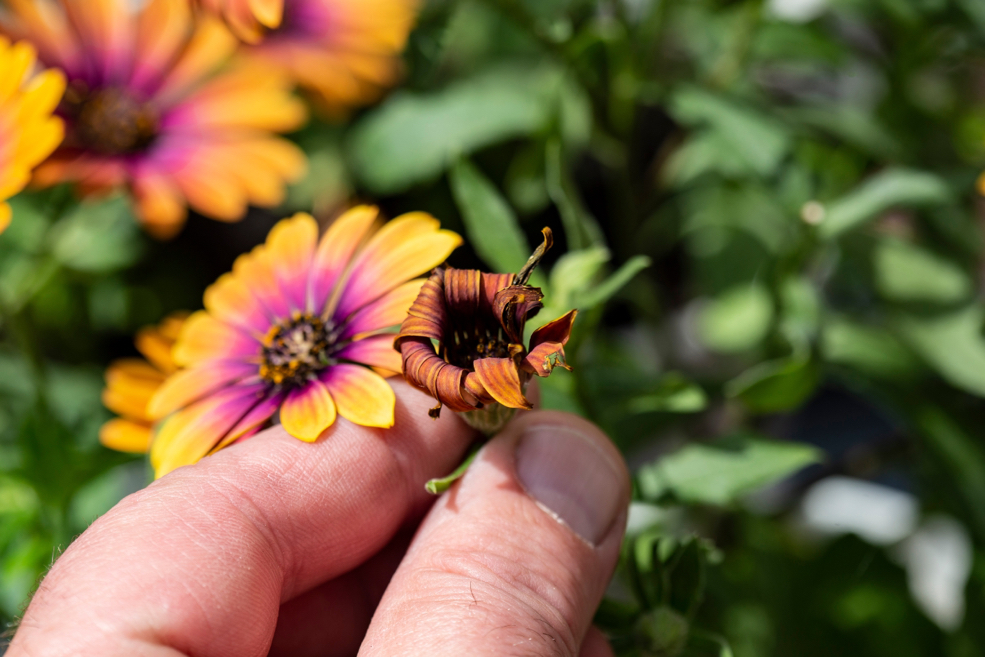Try Cutting Back Your Osteospermum In Late Spring Or Autumn For More Flowers

PERENNIALS > OSTEOSPERMUM > PRUNING
Reviewed By ROY NICOL

Roy is a Professional Gardener and Horticultural Consultant, specialising in large garden year-round maintenance and garden development. He is an RHS Master of Horticulture and uses his research in the application of no-dig methods in ornamental garden settings. Roy has been a Professional Gardener for more than six years and is a member of the Chartered Institute of Horticulture, Professional Gardener's Guild and Association of Professional Landscapers (Professional Gardener).
IN THIS GUIDE
OSTEOSPERMUM GUIDES
Common Problems
Cuttings Propagation
Growing From Seed
Pruning
Varieties
Winter Care
Osteospermum boasts beautiful daisy-like flowers in a variety of different colours, earning it the nickname African daisy.
Its long-lasting blooms and relative hardiness make it an ideal choice of perennial plant for British beds and borders.
Though the plant will flower reliably even in poorer quality soil and when left to its own devices, you can extend its blooming season and ensure it retains an aesthetically pleasing shape by pruning it regularly.
The process is a straightforward one and simply consists of the following steps:
- Prepare your tools (pruning shears or secateurs are most important).
- Cut back your Osteospermum in early spring or early autumn.
- Keep an eye out for spent or fading blooms in summer.
- Deadhead any spent blooms regularly.
For more information on each of those stages, check out our detailed explanations below.
| Difficulty | Easy |
| Equipment Required | Gardening gloves, pruning shears or secateurs, cloth, isopropyl alcohol |
| When To Prune | Cut back in early spring or early autumn, deadhead throughout summer |
When To Prune
It’s advisable to cut back your osteospermum plant in early spring or autumn, or even at both times if you wish to encourage fuller growth.
However, doing so on at least one occasion is imperative in preventing your plant from becoming overly tall and leggy.

It’s also a good idea to deadhead your African daisy throughout the blooming season since this will divert its energies away from seed production towards blossoming.
1) Prepare Your Tools
It’s vital that you ensure the tools you use are free from blight or disease.
As such, you must clean them thoroughly before and after use each time.
To do so, soak a cloth in isopropyl alcohol and rub the blades of your pruning shears to remove any impurities.
“It’s important to keep secateurs and shears clean by removing resin on a regular basis using a proprietary resin remover or cleaning eraser, and to keep them sharp using sharpening tools designed for this task,” says Master Horticulturist Roy Nicol.
“This will ensure clean cuts which will heal more readily – much better for the health of the plant.”
2) Cut Back In Late Spring Or Autumn
In order to maintain an aesthetically pleasing structure for your osteospermum’s growth, you should cut it back in late spring.
Use the shears to cut back the plant to at least half its original height, taking care to leave several leaf clusters on each stem.

Remove all cut foliage and dispose of it away from the plant to prevent the spread of disease.
You may repeat the process in autumn if you wish to instigate fuller growth.
3) Watch Out For Fading Blooms
It’s important to ensure that your plant devotes its energies to the areas which need them most.
This means discouraging seed production when we’d like the plant to be generating more flowers.
Identify flower heads that are beginning to turn brown in the centre or suffer from drooping petals, since these are the ones which must be removed in order to maintain a healthy plant and prolong the blooming season.
4) Deadhead Regularly
Having identified the blooms in need of attention, you should use the shears to cut back the offending party to where it joins the stem.
If all blooms on a stem are on their way out, you can cut back the entire stem to where it joins the main plant, leaving a small rosette of leaves to ensure further growth.

Remember to remove all discarded foliage and dispose of it far from the plant.
Deadheading should be undertaken as often as possible, but at least once a week during summertime.

